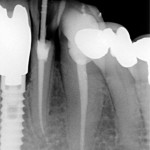
Obturation of the root canal following treatment is usually achieved using gutta percha (GP) and root canal sealers. The endodontic sealer should be able to create an effective bond between the walls of the root canal and the GP to prevent microleakage. Because of their properties epoxy resin-based sealers are the current gold standard. However, these resin-based endodontic sealers lack the bioactive properties or osteogenic potential of calcium silicate-based sealers and studies have suggested they may have superior performance to resin-based sealers.
The aim of this review was to compare the outcomes of silicate-based sealers with resin-based sealers in non-surgical root treatments.
Methods
A protocol was registered in the PROSPERO database and searches conducted in the PubMed/Medline, Directory of Open Access Journals (DOAJ), Cochrane Central Register of Controlled Trials, Web of Science, ClinicalTrials.gov, Google, Greylit and OpenGrey databases with no language limitations. Experimental studies conducted in patients ≥ 18 years of age requiring non-surgical endodontic treatment comparing silicate-based sealers and resin-based sealers were considered. Two reviewers selected studies, data was extracted with study quality being assessed using the Cochrane risk of bias tool for randomised controlled trials (RCTs) and the methodological index for non-randomised studies (MINORS) instrument for non-randomised studies. The certainty of the evidence was assessed using GRADE .
Results
- 12 studies (9 RCTs, 2 non-randomised, 1 retrospective) were included.
- Studies were conducted in India (3), Brazil (2), Turkey (2), and one each in in Egypt, Lithuania, Portugal, Russia and Singapore.
- In total 833 teeth were treated, 445 using calcium silicate-based sealers (CSBS) and 388 using with resin-based sealers (RBS).
- 5 RCTs were considered to be at low risk of bias, 3 at high risk and one at unclear risk.
- 8 studies contributed to the meta-analyses conducted for a number of outcomes as shown below –
| Mean pain levels | No. of studies | Standard mean difference (95%CI) |
| 24 hrs | 3 | -0.19 (-0.43 to -0.06) |
| 48 hrs | 2 | −0.35 (−0.64 to −0.05) |
| Risk of pain occurrence | No. of studies | Risk Ratio (95%CI) |
| 24 hrs | 7 | 1.01 (0.72 to 1.42) |
| 48 hrs | 6 | 1.09 (0.52 to 2.32) |
| 7 days | 3 | 2.08 (0.54 to 8.02) |
| Intensity of pain | No. of studies | Risk Ratio (95%CI) |
| Mild pain at 24 hrs | 6 | 0.90 (0.55 to 1.47) |
| Moderate pain at 24 hrs | 6 | 1.26 (0.65 to 2.46) |
| Mild pain at 48 hrs | 5 | 1.25 (0.54 to 2.89) |
| Moderate pain at 48hrs | 5 | 1.74 (0.29 to 10.25) |
| Mild pain at 7 days | 1 | 1.73 (0.43 to 7.00) |
| Moderate pain at 7 days | 2 | 3.00 (0.12 to 72.5) |
- There were no significant differences in analgesic medication intake within 24 hrs, RR= 07(95%CI; 0.29 to 3.90) [5 studies].
- No significant differences were seen for sealer extrusion, RR = 21(95%CI; 0.43 to 3.38) [2 studies].
Conclusions
The authors concluded: –
…CSBS presented acceptable performance with similar results to the gold standard RBS in terms of mean post-obturation pain level, risk of occurrence and intensity of pain at 24 and 48 h, as well as for analgesic drug intake within 24 h and extrusion of sealer. However, the included studies have shortcomings that were presented in this current review. Therefore, further well-designed, controlled randomised clinical trials for a period of at least four years are required to provide high-quality evidence.
Comments
The authors registered their protocol on the PROSPERO database and searched a broad range of databases with no restrictions. The narrative regarding the data abstraction and study quality assessment lacks clarity about independent and duplicate assessment of the studies although the abstract indicates that this was the case. Nine of the 12 studies meeting the inclusion criteria where RCTs with 5 of the 9 RCTs being considered to be at low risk of bias so initially restricting the review to RCTs would have been appropriate. As noted by the authors the included studies were heterogenous in relation to sample sizes number and experience of operators, tooth type, root canal preparation and number of visits. There was also variation in initial tooth/pulp condition and the outcome measures consequently future studies should follow CONSORT or PRIRATE recommendations and use common outcomes sets. While this review suggests similar performance for silicate-based sealers and resin-based sealers for non-surgical root treatments in the short-term addition high quality studies are needed to confirm these findings and assess longer term outcomes.
Links
Primary Paper
Chopra V, Davis G, Baysan A. Clinical and Radiographic Outcome of Non-Surgical Endodontic Treatment Using Calcium Silicate-Based Versus Resin-Based Sealers—A Systematic Review and Meta-Analysis of Clinical Studies. Journal of Functional Biomaterials. 2022; 13(2):38. https://doi.org/10.3390/jfb13020038
